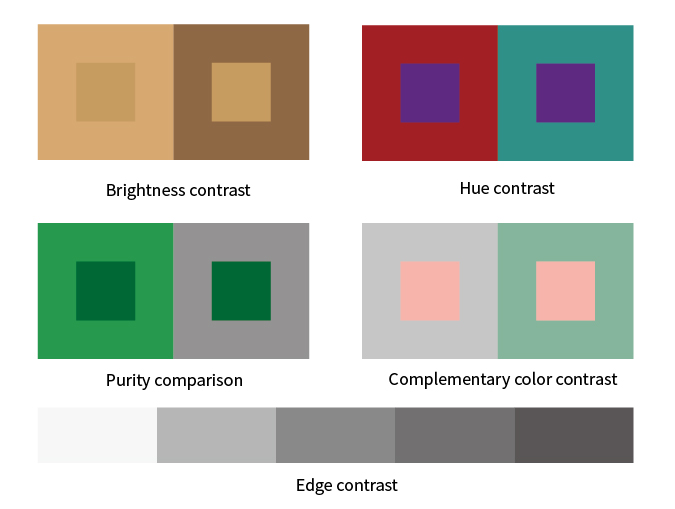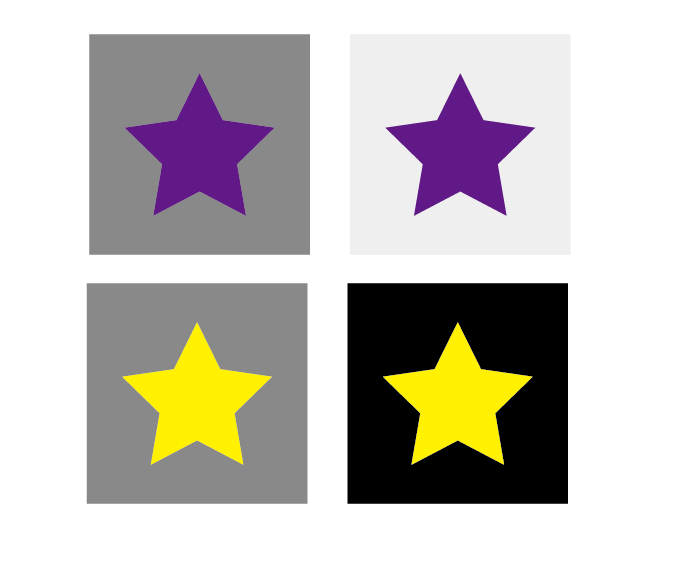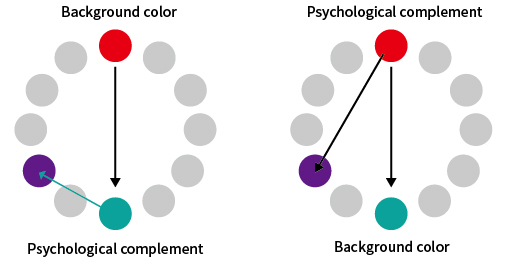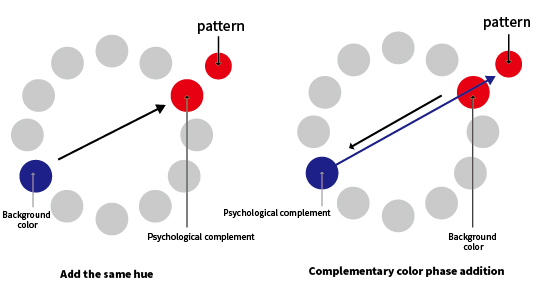Color Contrast
Color contrast refers to the phenomenon that the color including gray is viewed to the change in the opposite direction of its surrounding color. Color plays an important role in peoples sensory world, and it is also the most visual impact and attractive factor. Abundant color changes will produce our visual impact.
|
Successive Contrast
"Successive Contrast" refers to the effect of seeing different colors in turn between certain times. After lviewing the red figure, we can immediately move our eyes to the white place. At the beginning, you will see some residual images of the figures, and then we can go on seeing, they will slowly become blue-green. This phenomenon is called "complementary color residual image", and the color of the residual image is called "psychological color".
Psychological complementary color is the opposite color that can be confirmed in the hue ring and color system. In order to alleviate the visual fatigue caused by looking at specific colors all the time, people will generate psychological complementary colors on the retina. For example, the surgical clothes worn by doctors and the walls of the operating room are blue-green. This is to reduce the doctors who have been looking at red blood. The phenomenon of complementary color residuals caused by seeing the white clothes and walls can be alleviated. Even if the complementary color, blue-green appears, it can also absorb the same color around.
|
|
|
Simultaneous Contrast
"Simultaneous Contrast" refers to the phenomenon that when we see more than two colors, the colors will affect each other and produce different feelings when we are looking at a certain color alone. It will appear in the background color and graphic color, and connection with colors. The contrastive colors are classified according to the atmosphere for three attributes of the colors as follows: brightness contrast, hue contrast, and purity contrast. Furthemore, there are also phenomenas related to complex numbers.
|
|
|
Hue Contrast
The "hue contrast" refers to the contrast effect caused by the hue of adjacent colors in the case of different colors of the plural. If you put the same pattern on two different colors as the background color, it will induce the complementary color of the hue of the adjacent backgrounds color. It looks like mixing into the pattern. For example, on the complementary color relationship of red and blue-green background color, put the same color of the blue-violet graphics like the "stronger blue purple with blue" and "stronger blue purple with red". Affected by the psychological complement color, the figure seems like a mixture of red complementary blue-green and blue-green complementary red. The contrast effect is more obvious when the area difference between the background color and the graphics are larger. The brightness of the adjacent colors is closer, or the combination of high-purity colors is more effective.
|
|
|
Puirty Contrast
"Purity contrast" refers to the contrast effect caused by the purity of adjacent colors when the pluralx colors with different brightness are put together. The high purity color looks much brighter than the original, and the lower purity will look darker than the original one (Fig.1-91). As for purity contrast, it is easy to appear between the two colors with small color difference and brightness difference and much purity difference. On the background of high-purity blue and orange, when the orange pattern of medium purity is placed respectively, the blue one is added with orange under the influence of psychological complement color, and the blue pattern is added in the orange. The former one is consistent with the psychological complementary color of the pattern color, so the purity of the pattern color is higher. Thus, the color of the latter s pattern looks less pure because it is complementary to the color of the psychological complementary color.
|
|
|
Contrast of Complementary Colors
"Contrast of Complementary Colors" means the contrast effect caused by the influence of psychological complement color when the colors of complementary color relations are put together. Because the residual images of mutual psychological complement color coincide, the purity of color increases and it looks more vivid than the original one. In the case of small brightness difference of the same brightness combination, the contrast effect will be stronger, highlighting the brightness. As a result, the boundary line of the two colors is dazzling, and it is easy to have halos, which must be paid attention to.
|
|









